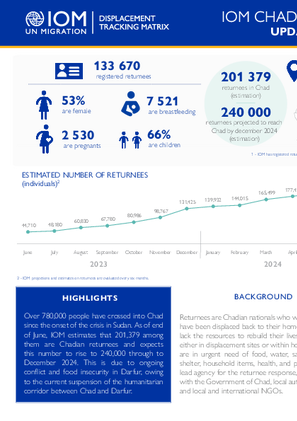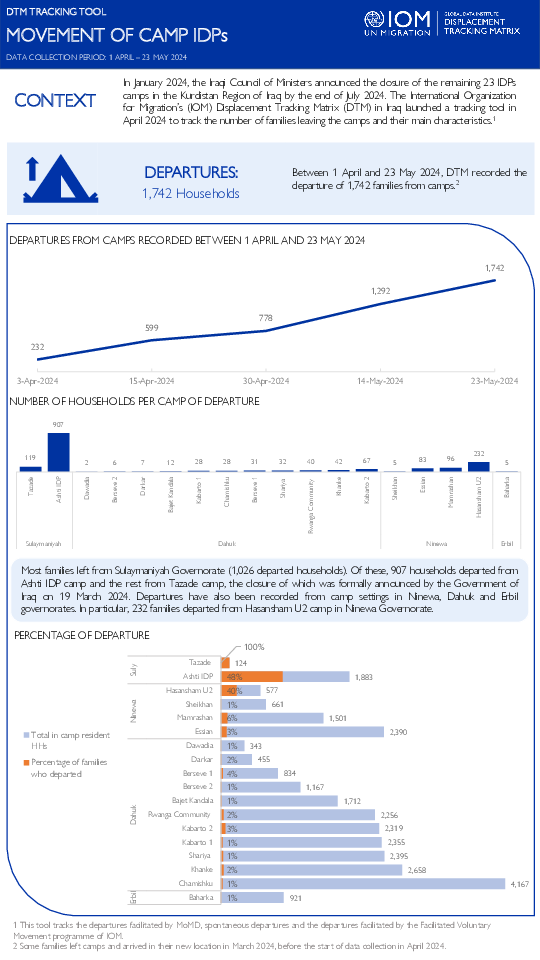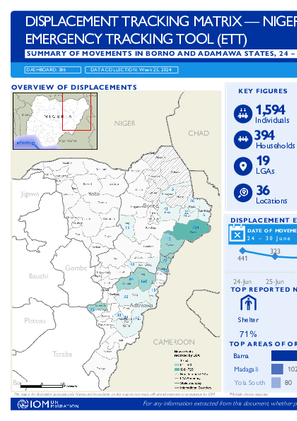-
Countries
-
Data and Analysis
-
Special Focus
-
Crisis Responses
Event Tracking

Contact
DTM DRC, iomdrcdtm@iom.int
Language
French
Location
Democratic Republic of the Congo
Period Covered
Jun 01 2024
Jul 05 2024
Activity
- Mobility Tracking
- Event Tracking
L'est de la République démocratique du Congo (RDC), en particulier le Nord-Kivu, est en proie à un conflit complexe et persistant. Ce conflit est caractérisé par la présence de différents groupes armés tels que le groupe armé M23, les Forces armées congolaises (FARDC) et leurs alliés respectifs, y compris les forces régionales de la Communauté de développement de l'Afrique australe, avec l'utilisation de munitions lourdes causant des dommages importants et des pertes en vies humaines dans les zones de déplacement du Nord et du Sud-Kivu.
Depuis le début du mois de juin 2024, le conflit s'est intensifié simultanément dans plusieurs villages des territoires déjà sous tension, dont le territoire de Lubero, qui est devenu le quatrième territoire du Nord-Kivu à être touché par la crise du M23, après les territoires de Rutshuru, Nyiragongo et Masisi. Ces affrontements, qui ont duré plusieurs jours, ont entraîné l'occupation par le groupe armé M23 de plusieurs villages et villes importants, notamment Kanyabayonga, Miriki, Luofu Kayna et Kirumba, ainsi que d'autres villages du territoire de Lubero.
Cette situation a entraîné d'importants déplacements de civils à l'intérieur et à l'extérieur de la province du Nord-Kivu. L'extension de la crise du M23 dans les territoires de Lubero et de Masisi au Nord-Kivu a accentué et aggravé la situation humanitaire des personnes déplacées, mais a également créé de nouvelles vagues de déplacement de la population vers des villages considérés comme stables au Sud-Kivu. La ville de Goma et les zones adjacentes aux territoires contrôlés par le M23 au Nord et au Sud-Kivu, accueillent un grand nombre de personnes déplacées et manquent de ressources pour les soutenir suffisamment.
Depuis le 4 juillet 2024, le gouvernement des États-Unis a annoncé une trêve humanitaire de deux semaines, à compter du 5 juillet 2024, pour permettre une désescalade des tensions au Nord et au Sud-Kivu, la reprise des pourparlers en vue d'un règlement pacifique du conflit, et pour aider la population civile à accéder à une assistance humanitaire cruciale dans les zones de déplacement.
Depuis le début de la crise, l'OIM, par le biais de la Matrice de suivi des déplacements (DTM), continue de mener une série d'évaluations rapides, y compris le suivi des situations d'urgence (EET/ERM), l'analyse des crises et l'enregistrement, avec pour priorité de répondre aux besoins d'information immédiats afin de comprendre la dynamique et les besoins des déplacements.
Ce rapport présente les résultats des évaluations menées dans les différentes zones de déplacement et de retour du 1 juin au 5 juillet 2024. Il couvre les déplacements et les retours liés à la crise M23.

Contact
DTM South Sudan, SouthSudanDTM@iom.int
Language
English
Location
South Sudan
Period Covered
Jun 01 2024
Jun 30 2024
Activity
- Mobility Tracking
- Event Tracking
South Sudan is grappling with a multifaceted humanitarian crisis marked by significant internal displacements. The factors fueling these displacement dynamics are diverse, encompassing communal clashes, land disputes, insecurity, violence, disasters, and cross-border movements.
During the period from the 1st to the 30th of June 2024, a sequence of events unfolded, resulting in the displacement of 7,381 individuals in Panyijar (4,476 individuals) and Tonj North counties (2,905 individuals). Insights gathered from key informants suggest that these displacements were primarily triggered by disasters, specifically floods. Consequently, these occurrences have given rise to pressing humanitarian needs, with affected populations highlighting shelter, food, and non-food items (NFIs) as their top three urgent requirements demanding immediate humanitarian intervention.

Contact
iomnigeriadtm@iom.int
Language
English
Location
Nigeria
Period Covered
Jul 01 2024
Jul 07 2024
Activity
- Registration
- Mobility Tracking
- Event Tracking
Between 01 and 07 July 2024, a total of 2,607 new arrivals were recorded at locations in Benue state. The new arrivals were recorded at locations in Agatu, Guma, Gwer-west, Logo, Nasarawa, and Ukum Local government areas (LGAs) of the conflict-affected Benue State.
ETT assessments identified the following movement triggers: conflict/attack (1,651 individuals or 63%), armed banditry/kidnapping (539 individuals or 21%), communal clash(225 individuals or 9%), and farmers-herders clash (191 individuals or 7%).
The majority of the arrivals were from Agatu LGA, with 1,575 individuals, which accounted for 60 per cent of the arrivals for the week. This was followed by arrivals from Ukum LGA with 646 individuals, which accounted for 25 per cent of the arrivals for the week. A total of 191 individuals arrived from Loko LGA. These arrivals account for seven per cent of the arrivals for the week.

Contact
DTM Chad, dtmtchad@iom.int
Language
English
Location
Chad
Period Covered
Jul 09 2024
Jul 09 2024
Activity
- Mobility Tracking
- Event Tracking
Over 780,000 people have crossed into Chad since the onset of the crisis in Sudan. As of end June 2024, IOM estimates that 201,379 among them are Chadian returnees and expects this number to rise to 240,000 through to December 2024. This is due to ongoing conflict and food insecurity in Darfur, owing to the current suspension of the humanitarian corridor between Chad and Darfur.
Returnees are Chadian nationals who were living in Sudan and have been displaced back to their home country where they lack the resources to rebuild their lives. Returnees are living either in displacement sites or within host communities. They are in urgent need of food, water, sanitation and hygiene shelter, household items, health, and protection. IOM is the lead agency for the returnee response, in close coordination with the Government of Chad, local authorities, UN agencies, and local and international NGOs.

Contact
DTM Support — iomdrcdtm@iom.int
Language
French
Location
Democratic Republic of the Congo
Period Covered
Mar 29 2024
Apr 26 2024
Activity
- Mobility Tracking
- Event Tracking
Ce tableau de bord présente les principaux résultats de suivi des mouvements de populations dans la province de l’Ituri à l’issue du onzième round d’évaluation conduit par l’unité de la Matrice de Suivi des Déplacements (Displacement Tracking Matrix, en anglais (DTM)) de l’Organisation Internationale pour les Migrations (OIM). Ces évaluations ont été réalisées à travers un exercice de collecte de données conduit du 29 mars au 26 avril 2024, en collaboration avec l’ONG locale, Réseau d’Action pour le Développement et le Progrès Intégré (RADPI), et la Commission Nationale pour les Réfugiés (CNR). Lors de ce cycle, un total de 6 529 villages, couvrant 36 zones de santé (ZS), ont été évalués à travers des consultations avec 17 166 informateurs clés.

Contact
iomnigeriadtm@iom.int
Language
English
Location
Nigeria
Period Covered
Jul 01 2024
Jul 07 2024
Activity
- Mobility Tracking
- Event Tracking
On 01, 03 and 04 July 2024, communal clashes occured in the community of Aila in Egba ward of Agatu local government area (LGA), armed bandits attacked the community of Samco Community in Borikyo ward of Ukum LGA and heavy rainfall occurred in the community of Achusa Market in Bar ward of Makurdi LGA all in Benue State. There were reports of 78 injuries and 28 fatalities. The attacks displaced 618 individuals in 135 households from Aila community to Obagaji host community in Obagaji ward. The affected individuals included 851 children, 387 women and 297 men.
On 04 and 06 July 2024, armed bandits attacked Model Primary School Camp in Gwadabawa ward of Gwadabawa LGA in Sokoto State and a communal clash occurred in the community of Sabuwar Unguwa in Wakili Kudu 3 ward of Katisna LGA in Katsina State. There were reports of 39 injuries and six fatalities. The affected individuals included 1,069 children, 549 women, and 304 men.
Of all the needs identified, food, non-food items (NFI), WASH, and transport were the most prevalent. Other needs included shelter, psychosocial support, and health.
Following these events, DTM (Displacement Tracking Matrix) field staff conducted rapid assessments to inform the humanitarian community and Government/partners, and to enable a targeted response.
Nigeria’s north-central and north-west zones are afflicted with a multi-dimensional crisis. Long-standing tensions between ethnic and religious groups often result in attacks and banditry or hirabah. These attacks involve kidnapping and grand larceny along major highways by criminal groups. During the past years, the crisis accelerated and has resulted in widespread displacement across the north-central and north-west regions.

Contact
IraqDTM@iom.int
Language
English
Location
Iraq
Period Covered
Apr 01 2024
May 23 2024
Activity
- Mobility Tracking
- Event Tracking
In January 2024, the Iraqi Council of Ministers announced the closure of the remaining 23 IDPs camps in the Kurdistan Region of Iraq by the end of July 2024. The International Organization for Migration’s (IOM) Displacement Tracking Matrix (DTM) in Iraq launched a tracking tool in April 2024 to track the number of families leaving the camps and their main characteristics.

Contact
iomnigeriadtm@iom.int
Language
English
Location
Nigeria
Period Covered
Jun 24 2024
Jun 30 2024
Activity
- Mobility Tracking
- Event Tracking
Between 24 and 30 June 2024, a total of 1,594 new arrivals were recorded at locations in Adamawa and Borno states. The new arrivals were recorded at locations in Askira/Uba, Bama, Dikwa, Gwoza, Kaga, Kala Balge, Mafa, Monguno and Ngala Local Government Areas (LGAs) of the most conflict-affected Borno State, and in Fufore, Gombi, Hong, Lamurde, Madagali, Maiha, Michika, Song, Yola North and Yola South LGAs of Adamawa State.
ETT assessments identified the following movement triggers: military operations (548 individuals or 34%), poor living conditions (377 individuals or 24%), improved security (315 individuals or 20%), seasonal farming (175 individuals or 11%), family re-unification (90 individuals or 6%), fear of attack (42 individuals or 2%), camp closure (31 individuals or 2%) and access to humanitarian support (16 individuals or 1%).

Contact
DTM Yemen, iomyemendtm@iom.int
Language
English
Location
Yemen
Period Covered
Jun 30 2024
Jul 06 2024
Activity
- Mobility Tracking
- Event Tracking
IOM Yemen DTM’s Rapid Displacement Tracking (RDT) tool collects data on estimated numbers of households forced to flee on a daily basis from their locations of origin or displacement, allowing for regular reporting of new displacements in terms of estimated numbers, geography, and needs. It also tracks returnees who returned to their location of origin.
From 1 January to 6 July 2024, IOM Yemen DTM tracked 1,688 households (HH) (10,128 Individuals) who experienced displacement at least once.
Between 30 June and 6 July 2024, IOM Yemen DTM tracked 44 households (264 individuals) displaced at least once. The majority of people moved into/within the following governorates and districts:
- Ma’rib (31 HHs) – Al Abdiyah (15 HHs), Ma’rib City (8 HHs), Ma’rib (8 HHs) districts. Most displacements in the governorate originated from Ma’rib and Al Jawf.
- Ta’iz (7 HHs) – Jabal Habashi (5 HHs), Al Maafer (2 HHs) districts. Most displacements in the governorate originated from Ta’iz and Al Hodeidah.
- Al Hodeidah (4 HHs) – Hays (4 HHs) district. Most displacements in the governorate originated from Al Hodeidah and Ta’iz.
The majority of people moved from the following governorates and districts:
- Ma’rib (17 HHs) – Al Abdiyah (15 HHs), Bidbadah (1 HH), Harib (1 HH) districts.
- Ta’iz (8 HHs) – Maqbanah (5 HHs), Al Mudhaffar (1 HH), Jabal Habashi (1 HH) district.
- Al Hodeidah (7 HH) – Al Jarrahi (4 HHs), Al Qanawis (1 HH), Al Hawak (1 HH) districts.
IOM identified 22 additional households displaced in the previous reporting period, which covered 23 - 29 June 2024, in the governorates of Al Hodeidah (12 HHs), and Ma’rib (10 HHs). These figures have been added to the cumulative displacement total recorded since the beginning of the year.
Contact
DTM Yemen, iomyemendtm@iom.int
Location
Yemen
Activity
- Mobility Tracking
- Event Tracking
Period Covered
Jun 30 2024 -Jul 06 2024
From 1 January to 6 July 2024, IOM Yemen DTM tracked 1,688 households (HH) (10,128 Individuals) who experienced displacement at least once.
Between 30 June and 6 July 2024, IOM Yemen DTM tracked 44 households (264 individuals) displaced at least once. The majority of people moved into/within the following governorates and districts:
- Ma’rib (31 HHs) – Al Abdiyah (15 HHs), Ma’rib City (8 HHs), Ma’rib (8 HHs) districts. Most displacements in the governorate originated from Ma’rib and Al Jawf.
- Ta’iz (7 HHs) – Jabal Habashi (5 HHs), Al Maafer (2 HHs) districts. Most displacements in the governorate originated from Ta’iz and Al Hodeidah.
- Al Hodeidah (4 HHs) – Hays (4 HHs) district. Most displacements in the governorate originated from Al Hodeidah and Ta’iz.
The majority of people moved from the following governorates and districts:
- Ma’rib (17 HHs) – Al Abdiyah (15 HHs), Bidbadah (1 HH), Harib (1 HH) districts.
- Ta’iz (8 HHs) – Maqbanah (5 HHs), Al Mudhaffar (1 HH), Jabal Habashi (1 HH) district.
- Al Hodeidah (7 HH) – Al Jarrahi (4 HHs), Al Qanawis (1 HH), Al Hawak (1 HH) districts.
Population Groups
IDPs
Returnee (Previously Internally Displaced)
Survey Methodology
Unit of Analysis Or Observation
Admin Area 2
Type of Survey or Assessment
Household
Key Informant
Keywords
Geographical Scope Partial Coverage
Administrative boundaries with available data
The current dataset covers the following administrative boundaries
Pagination
- Previous page
- Page 24
- Next page
